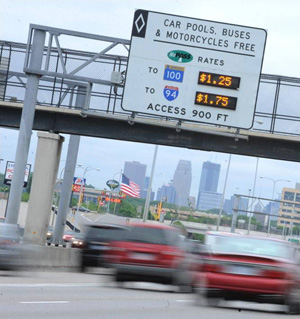Active Demand Management
Definition

Source – Minnesota DOT

Source – Zipcar.com
Active demand management (ADM) uses information and technology to dynamically manage demand, which could include redistributing travel to less congested times of day or routes, or reducing overall vehicle trips by influencing a mode choice.
ADM seeks to influence more fluid, daily travel choices to support more traditional, regular mode choice changes. For example, the parking arrival incentive program pilot, Congestion And Parking Relief Incentives (CAPRI), at Stanford seeks to reduce the number of cars from parking at peak times while the overall TDM program at Stanford, through its Commute Club, offers other incentives to use alternative modes, including cash incentives to not purchase a long term parking permit. ADM is very supportive of other active measures by redistributing or reducing overall traffic levels during congested conditions, thus becoming an integral part of an overall management philosophy to actively manage a facility or system.
Examples of Strategies
- Dynamic Fare Reduction: This strategy involves reducing the fare for use of the transit system in a particular corridor as congestion or delay on that corridor increases. This encourages selection of transit mode to reduce traffic volumes entering the corridor. Fare changes are communicated in real-time to the traveling public, through general dissemination channels such as the transit web site, as well as personalized messages to subscribers. In an ATDM approach, real-time and predicted highway congestion levels and/or the utilization levels of the transit system can be used to adjust transit fare in real-time to encourage mode shift necessary to meet agencies goals and objectives.
- Dynamic High-Occupancy Vehicle (HOV) / Managed Lanes: This strategy involves dynamically changing the qualifications for driving in a high-occupancy vehicle (HOV) lane(s). HOV lanes (also known as carpool lanes or diamond lanes) are restricted traffic lanes reserved at peak travel times or longer for exclusive use of vehicles with a driver and one or more passengers, including carpools, vanpools and transit buses. The normal minimum occupancy level is 2 or 3 occupants. Many agencies exempt other vehicles, including motorcycles, charter buses, emergency and law enforcement vehicles, low emission vehicles, and/or single-occupancy vehicles paying a toll. In an ATDM approach, the HOV lane qualifications are dynamically changed based on real-time or anticipated conditions on both the HOV and general purpose lanes. Qualifications that can potentially be dynamically adjusted include the number of occupants (e.g., from 2 to 3 occupants), the hours of operation, and the exemptions (e.g., change from typical HOV operation to buses only). Alternatively, the HOV restrictions could be dynamically removed allowing general use of the previously managed lane.
- Dynamic Pricing: This strategy utilizes tolls that dynamically change in response to changing congestion levels, as opposed to variable pricing that follows a fixed schedule. In an ATDM approach, real-time and anticipated traffic conditions can be used to adjust the toll rates to achieve agency goals and objectives.
- Dynamic Ridesharing: This strategy involves travelers using advanced technologies, such as smart phones and social networks, to arrange a short-notice, one-time, shared ride. This facilitates real-time and dynamic carpooling to reduce the number of auto trips/vehicles trying to use already congested roadways.
- Dynamic Routing: This strategy uses variable destination messaging to disseminate information to make better use of roadway capacity by directing motorists to less congested facilities. These messages could be posted on dynamic message signs in advance of major routing decisions. In an ATDM approach, real-time and anticipated conditions can be used to provide route guidance and distribute the traffic spatially to improve overall system performance.
- Dynamic Transit Capacity Assignment: This strategy involves re-organizing schedules and adjusting assignments of assets (e.g., buses) based on real-time demand and patterns, to cover the most overcrowded sections of network. In an ATDM approach, real-time and predicted travel conditions can be used to determine the changes needed to the planned transit operations, thereby potentially reducing traffic demand and subsequent delays on roadway facilities.
- On-Demand Transit: This strategy involves travelers making real-time trip requests for services with flexible routes and schedules. This allows users to request a specific transit trip based on their individual trip origin/destination and desired departure or arrival time.
- Predictive Traveler Information: This strategy involves using a combination of real-time and historical transportation data to predict upcoming travel conditions and convey that information to travelers pre-trip and en-route (such as in advance of strategic route choice locations) in an effort to influence travel behavior. In an ATDM approach, predictive traveler information is incorporated into a variety of traveler information mechanisms (e.g., multi-modal trip planning systems, 511 systems, dynamic message signs) to allow travelers to make better informed choices.
- Transfer Connection Protection: This strategy involves improving the reliability of transfers from a high frequency transit service (e.g., a train) to a low frequency transit service (e.g., a bus). For example, the train is running late, so the bus is held back so train passengers can make their connection with the bus; or providing additional bus services at a later time to match the late arrival time of the train. This ensures that the connections are not missed.
| Project | Location(s) | ADM Strategy(ies) | Active Technologies |
|---|---|---|---|
| I-10 Katy Expressway | Houston, TX | Dynamic pricing | Dynamic pricing of HOT lanes and incentives for transit and HOV usage |
| I-15 Express Lanes | Salt Lake City, UT | Dynamic pricing | Dynamic pricing of HOT lanes and incentives for transit and HOV usage |
| I-35W HOT Lanes | Minneapolis, MN | Dynamic pricing | Dynamic pricing of HOT lanes and incentives for transit and HOV usage |
| I-680 Express Lane | San Francisco, CA | Dynamic pricing | Dynamic pricing of HOT lanes and incentives for transit and HOV usage |
| SR 167 HOT Lanes | Seattle, WA | Dynamic pricing | Dynamic pricing of HOT lanes and incentives for transit and HOV usage |
| I-85 Express Lanes | Atlanta, GA | Dynamic pricing | Dynamic pricing of HOT lanes and incentives for transit and HOV usage |
| I-110 and I-10 Express Lanes | Los Angeles, CA | Dynamic pricing | Dynamic pricing of HOT lanes and incentives for transit and HOV usage |
| Integrated Corridor Management | Dallas, TX (U.S. 75) / San Diego, CA (I-15) | Decision support systems, real-time intermodal information | Synthesis of transit, parking, freeway, and arterial information, decision support system responses, prediction capability |
| SR 520 Bridge Tolling | Seattle, WA | Dynamic Pricing | Dynamic all-electronic tolling (used to manage congestion and raise funds for replacement bridge) |
